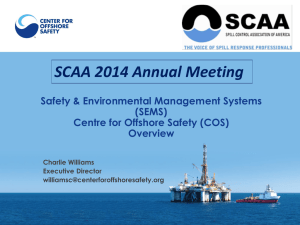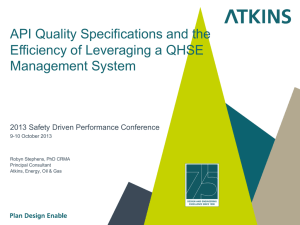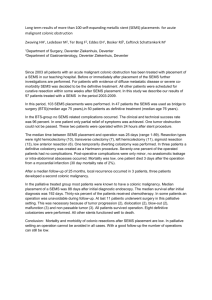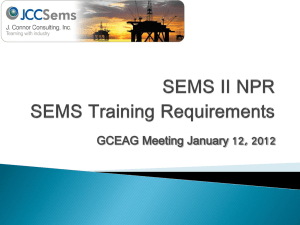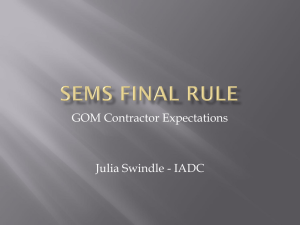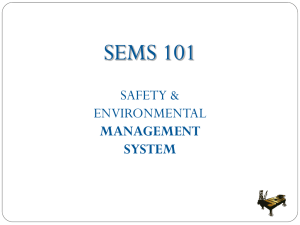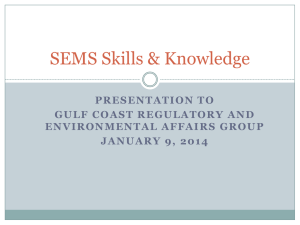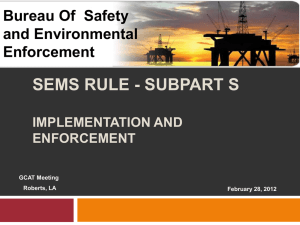MH Presentation Template 2012
advertisement
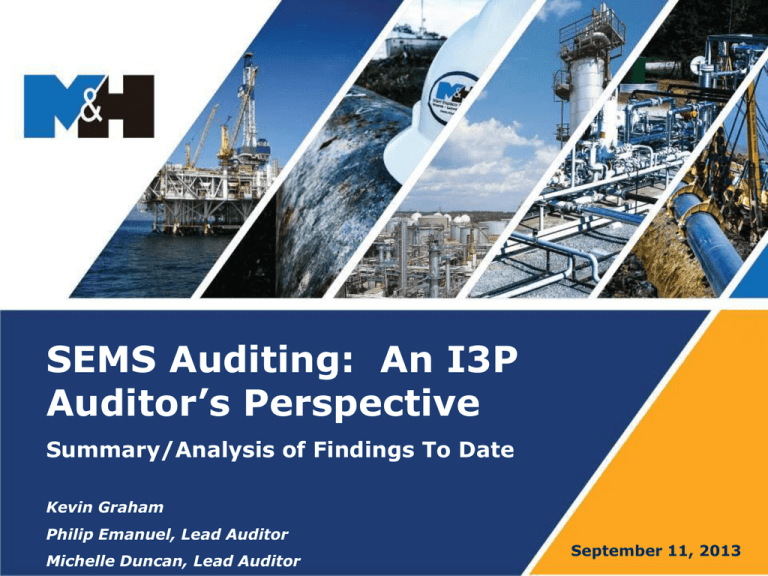
SEMS Auditing: An I3P Auditor’s Perspective Summary/Analysis of Findings To Date Kevin Graham Philip Emanuel, Lead Auditor Michelle Duncan, Lead Auditor September 11, 2013 About M&H M&H • Established in 1978 • More than 250 engineering and technical professionals • Offices in Houston and Lafayette • First I3P to conduct SEMS audit (Directed) • More than 2 dozen SEMS audits completed or in process Our Services • Regulatory Compliance • Project Management • Design Engineering • Information Technology • Maintenance Management • Technical Documentation │2│ Our Approach to SEMS Auditing Three types of Audits 1. Commissioned Contractor Audits 2. Gap Analysis • No Audit Plan, Final Report, or CAP submitted to BSEE 3. Formal I3P Audit Based on COS SEMS Audit Protocol M&H Presentation Photo Caption • Some items reorganized into separate questions • Placeholder for Operator-specific requirements not required by Subpart S or API RP75 │3│ Three Phases (Gap Analysis/I3P) Phase I: • Corporate-level documentation; program documents/procedures • Conducted at M&H offices Phase II: • Program implementation • Conducted at Operator’s corporate office/shorebase location Phase III: • Program implementation (facility-specific) • Site visit to each facility identified in Audit Plan Number of Protocol Requirements by Element/Phase No of Requirements (Full Protocol) Element Phase I Phase II Phase III Total Percent 1 - General 33 16 0 49 11.92% 2 - Safety and Environmental 9 21 0 30 7.30% 3 - Hazard Analysis 5 25 6 36 8.76% 4 - Management of Change 17 5 0 22 5.35% 5 - Operating Procedures 23 3 2 28 6.81% 6 - Safe Work Practices 21 16 7 44 10.71% 7 - Training 8 - Assurance of Quality and Mechanical Integrity 12 34 18 4 1 6 31 44 7.54% 10.71% 9 - Pre-Startup Review 8 0 0 8 1.95% 10 - Emergency Response and Control 4 15 0 19 4.62% 11 - Investigation of Incidents 3 10 0 13 3.16% 12 - Audit of SEMS Program Elements 27 40 0 67 16.30% 13 - Records and Documentation 2 15 1 18 4.38% NA - Operator-Specific 1 0 1 2 0.49% 199 188 24 411 100.00% 45.74% 5.84% 100.00% Total Percent 48.42% Number of Protocol Requirements by Element Audit Protocol: Number of Unique Requirements (by SEMS Element) NA - Operator-Specific 2 18 13 - Records and Documentation 67 12 - Audit of SEMS Program Elements 13 11 - Investigation of Incidents 19 10 - Emergency Response and Control 9 - Pre-Startup Review 8 44 8 - Assurance of Quality and Mechanical Integrity 31 7 - Training 44 6 - Safe Work Practices 28 5 - Operating Procedures 4 - Management of Change 22 36 3 - Hazard Analysis 2 - Safety and Environmental 1 - General 30 49 Number of Protocol Requirements by Element/Phase Audit Protocol: Number of Phase I, II, and III Requirements (by SEMS Element) Phase I 80 70 60 50 40 30 20 10 0 Phase II Phase III Our Sample (Data Set) 16 Separate Audits • Includes Gap Analysis and/or Formal I3P Audits • Gap Analysis Audits: 4 • 2 of these subsequently accepted by BSEE as meeting formal audit requirements • I3P Audits: 12 • 3 of these were BSEE-Directed • 1 of these utilized an Operator-defined protocol (not the COS Protocol) • 1 of these included only Phase I and II • Included both production and drilling (where appropriate) No of Findings (Deficiencies) by Element/Phase No of Requirements where Findings Occurred Phase I Phase II Phase III Total Percent 1 - General 17 5 0 22 11.89% 2 - Safety and Environmental 6 2 0 8 4.32% 3 - Hazard Analysis 2 12 2 16 8.65% 4 - Management of Change 13 4 0 17 9.19% 5 - Operating Procedures 21 1 1 23 12.43% 6 - Safe Work Practices 15 1 6 22 11.89% 7 - Training 8 - Assurance of Quality and Mechanical Integrity 10 13 8 2 0 6 18 21 9.73% 11.35% 9 - Pre-Startup Review 2 0 0 2 1.08% 10 - Emergency Response and Control 1 4 0 5 2.70% 11 - Investigation of Incidents 3 1 0 4 2.16% 12 - Audit of SEMS Program Elements 16 5 0 21 11.35% 13 - Records and Documentation 2 1 1 4 2.16% NA - Operator-Specific 1 0 1 2 1.08% 122 46 17 185 100.00% 24.86% 9.19% 100.00% Total Percent 65.95% No of Findings (Deficiencies) by Element/Phase Occurrence of Phase I Findings (by SEMS Element) NA - Operator-Specific 1 2 13 - Records and Documentation 16 12 - Audit of SEMS Program Elements 3 11 - Investigation of Incidents 10 - Emergency Response and Control 9 - Pre-Startup Review 1 2 13 8 - Assurance of Quality and Mechanical Integrity 10 7 - Training 15 6 - Safe Work Practices 21 5 - Operating Procedures 13 4 - Management of Change 3 - Hazard Analysis 2 - Safety and Environmental 1 - General 2 6 17 No of Findings (Deficiencies) by Element/Phase Occurrence of Phase II Findings (by SEMS Element) NA - Operator-Specific 0 1 13 - Records and Documentation 5 12 - Audit of SEMS Program Elements 1 11 - Investigation of Incidents 4 10 - Emergency Response and Control 9 - Pre-Startup Review 0 2 8 - Assurance of Quality and Mechanical Integrity 8 7 - Training 6 - Safe Work Practices 1 5 - Operating Procedures 1 4 4 - Management of Change 12 3 - Hazard Analysis 2 - Safety and Environmental 1 - General 2 5 No of Findings (Deficiencies) by Element/Phase Occurrence of Phase III Findings (by SEMS Element) NA - Operator-Specific 1 13 - Records and Documentation 1 12 - Audit of SEMS Program Elements 0 11 - Investigation of Incidents 0 10 - Emergency Response and Control 0 9 - Pre-Startup Review 0 6 8 - Assurance of Quality and Mechanical Integrity 7 - Training 0 6 6 - Safe Work Practices 1 5 - Operating Procedures 4 - Management of Change 0 2 3 - Hazard Analysis 2 - Safety and Environmental 0 1 - General 0 Occurrence of Findings by Phase/Element – Difficulty Ranking Rate at Which Findings Occurred Phase I Phase II Phase III Total Element/Phase Difficulty (Findings) Ranking PH I Rank PHII Rank PHIII Rank Overall Rank 1 - General 51.52% 31.25% NA 44.90% 9 6 NA 6 2 - Safety and Environmental 66.67% 9.52% NA 26.67% 7 10 NA 10 3 - Hazard Analysis 40.00% 48.00% 33.33% 44.44% 10 3 5 7 4 - Management of Change 76.47% 80.00% NA 77.27% 5 1 NA 2 5 - Operating Procedures 91.30% 33.33% 50.00% 82.14% 3 5 4 1 6 - Safe Work Practices 71.43% 6.25% 85.71% 50.00% 6 12 3 4 7 - Training 83.33% 44.44% 0.00% 58.06% 4 4 6 3 8 - Assurance of Quality and Mechanical Integrity 38.24% 50.00% 100.00% 47.73% 11 2 1 5 9 - Pre-Startup Review 25.00% NA NA 25.00% 12 13 NA 12 10 - Emergency Response and Control 25.00% 26.67% NA 26.32% 12 7 NA 11 11 - Investigation of Incidents 100.00% 10.00% NA 30.77% 1 9 NA 9 12 - Audit of SEMS Program Elements 59.26% 12.50% NA 31.34% 8 8 NA 8 13 - Records and Documentation 100.00% 6.67% 100.00% 22.22% 1 11 1 13 NA - Operator-Specific 100.00% NA 100.00% 100.00% Element 5 - Operating Procedures: Most Common Deficiencies 1. Failure to adequately address: a. “Simultaneous Operations” b. “Temporary Operations” c. “Any lease or concession stipulations established by recognized governmental authority” d. “Continuous and periodic discharge of hydrocarbon materials, contaminants, or undesired by-products into the environment is restricted by governmental limitations” e. “Raw materials used in operations and the quality control procedures used in purchasing these raw materials” 2. Consideration of human factors associated with format, content, and intended use of operating procedures 3. Failure to include job title and reporting relationship of the person(s) responsible for each of the facility’s operating areas 4. Failure to consistently implement operating procedures Element 4 - Management of Change: Most Common Deficiencies 1. MOC procedures fail to address: a. Duration of the change, if temporary b. Necessary time period to implement changes c. Communication of the proposed change and the consequences of that change to appropriate personnel 2. Employees not adequately informed of the change prior to startup of the process or affected part of operation 3. Employees not trained in the change prior to startup of the process of affected part of operation 4. Where MOC results in a change in operating procedures, such changes not documented/dated Element 7 - Training: Most Common Deficiencies 1. Refresher training not provided to maintain understanding of and adherence to current operating procedures 2. Failure to develop procedures for evaluating whether personnel possess the required knowledge and skills to carry out their duties and responsibilities, including startup and shutdown 3. Failure to develop and implement qualification criteria for operating and maintenance personnel 4. Failure of training program to address operating procedures Element 6- Safe Work Practices: Most Common Deficiencies 1. Failure to consider human factors in development of safe work practices 2. No work authorization or “permit-to-work” system implemented for tasks involving lockout and tagout of electrical and mechanical energy sources 3. Failure to include provisions in permit-to-work system for adequate communication of work activities to shift changes and replacement personnel 4. Failure to include contractors in permit-to-work communications 5. Failure to develop and implement safe work practices to control the presence, entrance, and exit of contract employees in operation areas. Element 8- Assurance of Quality/Mechanical Integrity: Most Common Deficiencies 1. Failure to document for each inspection/test performed of equipment/systems: a. Name, position, and signature of the person who performed the inspection/test b. Date of inspection/test 2. Failure of Mechanical Integrity procedures to address modification of existing equipment and systems and failure to ensure that procedures are modified for the application for which they will be used 3. Failure of testing, inspection, calibration, and monitoring programs for critical equipment to include: a. Documentation of completed testing and inspection i. Pressure vessel testing/inspection documentation not maintained for life of equipment ii. All other documentation not retained for a minimum of 2 years or as needed b. Appropriate auditing procedures to ensure compliance with the program General Notes and Other Observations • Most common findings in “other” elements a. Failure to analyze/critique emergency response drills for the purpose of identifying and correcting weaknesses (Element 10 – Emergency Response) b. Failure of the supervisor of the person in charge of the task to approve the JSA prior to commencement of the work (Element 3 – Hazards Analysis) • Management commitment/involvement led to fewer findings • Key variable in determining time/cost required to conduct audit has been quality of “Document/Records Management System” – not size of Operator company or number of facilities. General Notes and Other Observations • The more robust the MOC program/process, the fewer program deficiencies • Level of BSEE involvement/participation in audits has varied • Competing mindsets: Is this about compliance? Or is this about management systems? • No clear definition/approach yet in verifying knowledge/skills • Greater focus on the “E” in SEMS is coming
